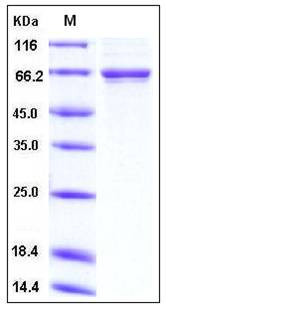Human TGFBI / BIGH3 Protein (His Tag)
BIGH3,CDB1,CDG2,CDGG1,CSD,CSD1,CSD2,CSD3,EBMD,LCD1
- 100ug (NPP2537) Please inquiry
| Catalog Number | P10569-H08H |
|---|---|
| Organism Species | Human |
| Host | Human Cells |
| Synonyms | BIGH3,CDB1,CDG2,CDGG1,CSD,CSD1,CSD2,CSD3,EBMD,LCD1 |
| Molecular Weight | The secreted recombinant human beta IG-H3 comprises 671 amino acids with a predicted molecular mass of 74 kDa. As a result of glycosylation, the apparent molecular mass of rh beta IG-H3 is approximately 65 kDa in SDS-PAGE under reducing conditions. |
| predicted N | Gly 24 |
| SDS-PAGE |  |
| Purity | > 75 % as determined by SDS-PAGE |
| Protein Construction | A DNA sequence encoding the extracellular domain of human beta IG-H3 (NP_000349.1) precursor (Met 1-His 683) was expressed, fused with a polyhistidine tag at the C-terminus. |
| Bio-activity | |
| Research Area | Developmental Biology |Organogenesis |Excretory system development |Kidney development |
| Formulation | Lyophilized from sterile PBS, pH 7.4 1. Normally 5 % - 8 % trehalose, mannitol and 0.01% Tween80 are added as protectants before lyophilization. Specific concentrations are included in the hardcopy of COA. |
| Background | TGFBI is an RGD-containing protein that binds to type I, II and IV collagens. The RGD motif is found in many extracellular matrix proteins modulating cell adhesion and serves as a ligand recognition sequence for several integrins. TGFBI plays a role in cell-collagen interactions and may be involved in endochondrial bone formation in cartilage. TGFBI is induced by transforming growth factor-beta and acts to inhibit cell adhesion. Mutations in TGFBI are associated with multiple types of corneal dystrophy. TGFBI can bind to type I, II, and IV collagens. This adhesion protein may play an important role in cell-collagen interactions. In cartilage, TGFBI may be involved in endochondral bone formation. Loss of the TGFBI is sufficient to induce specific resistance. |
| Reference |
